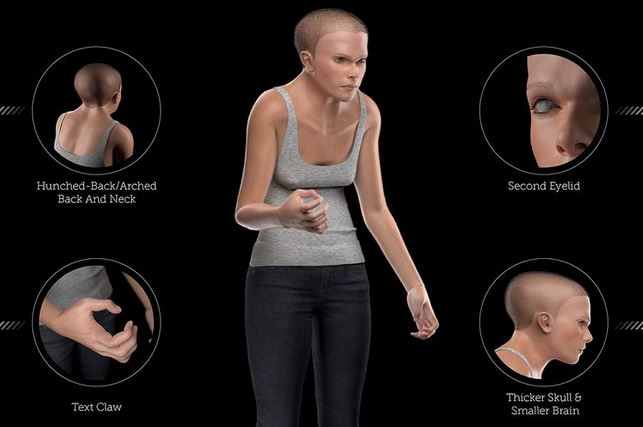
The effects of modern technology on the human body is a subject of fascination for many scientists.
From carpal tunnel syndrome and eye strain to the condition known as "tech neck", the negative effects of prologued technology use are well documented.
Now one company has created a 3D model of a future human, based on some of these scientific predictions - and the result is truly horrifying.
Dubbed "Mindy", the human of 2100 has a hunched back, caused by hours sitting in front of a computer monitor at the office and craning her neck to look at smartphones.
Her neck muscles have also grown to limit the damage caused by poor posture due to monitor and smartphone use.
"Spending hours looking down at your phone strains your neck and throws your spine off balance," said Caleb Backe, a health and wellness expert at Maple Holistics.
"Consequently, the muscles in your neck have to expend extra effort to support your head.
"Sitting in front of the computer at the office for hours on end also means that your torso is pulled out in front of your hips rather than being stacked straight and aligned."
Mindy's adaptations don't stop there. Her skull has thickened, helping to protect her brain from radiofrequency radiation emitted from smartphones - which some believe can have serious health implications.
Her brain has also shrunk, based on the recent scientific theory that a sedentary lifestyle is reducing human brain capacity.
Meanwhile, her hand has permanently molded into a claw-like grip and her elbow is bent to 90 degrees, due to sustained periods spent holding a smartphone.
"The way we hold our phones can cause strain in certain points of contact – causing 'text claw' and '90-degree elbow' also known as the cubital tunnel syndrome," said Dr Nikola Djordjevic from Med Alert Help.
"This syndrome is caused by pressure or the stretching of the ulnar nerve which runs in a groove on the inner side of the elbow.
"This causes numbness or a tingling sensation in the ring and little fingers, forearm pain, and weakness in the hands - keeping the elbow bent for a long time."
Stay informed. Subscribe to our newsletter
Mindy's final physical change is possibly her most outlandish - she has a second set of eyelids to filter out excessive light emitted from technology devices.
Kasun Ratnayake from the University of Toledo suggests this radical evolutionary development could limit the amount of harmful light our eyes are exposed to.
"Humans may develop a larger inner eyelid to prevent exposure to excessive light, or the lens of the eye may be evolutionary developed such that it blocks incoming blue light but not other high wavelength lights like green, yellow or red," he said.
While the Mindy model is extreme, and designed to shock, it provides an interesting visual representation of a growing body of scientific research.
"Technology gives us convenience, connectivity, entertainment, and so much more – but there is a trade-off," said Jason O'Brien, COO of TollFreeForwarding.com, which commissioned the model.
"Overexposure to technology can sometimes come to the detriment of our health.
"While the benefits of technology to individuals and businesses are too great to ignore, it's worth evaluating your usage to ensure your health isn't being damaged in the long-term."
 The Standard Group Plc is a
multi-media organization with investments in media platforms spanning newspaper
print operations, television, radio broadcasting, digital and online services. The
Standard Group is recognized as a leading multi-media house in Kenya with a key
influence in matters of national and international interest.
The Standard Group Plc is a
multi-media organization with investments in media platforms spanning newspaper
print operations, television, radio broadcasting, digital and online services. The
Standard Group is recognized as a leading multi-media house in Kenya with a key
influence in matters of national and international interest.
 The Standard Group Plc is a
multi-media organization with investments in media platforms spanning newspaper
print operations, television, radio broadcasting, digital and online services. The
Standard Group is recognized as a leading multi-media house in Kenya with a key
influence in matters of national and international interest.
The Standard Group Plc is a
multi-media organization with investments in media platforms spanning newspaper
print operations, television, radio broadcasting, digital and online services. The
Standard Group is recognized as a leading multi-media house in Kenya with a key
influence in matters of national and international interest.





